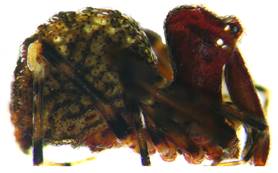The assassin spider is not dead on Kangaroo Island!
Researchers have found an ancient species of spider, feared to be extinct after devastating Kangaroo Island bushfires in South Australia in 2020.
The spider, known as the assassin spider (Zephyrarchaea austini), was known to live in the Western River Regional Protection Area on Kangaroo Island.
The bushfire burnt through more than 200,000 hectares of bush and farmland across the island nearly two years ago.
But two individuals have been found in a small patch of leaf litter which was outside the previous known range of the spider on Kangaroo Island, according to Jessica Marsh, an honorary research associate at the South Australian Museum.
"It was amazing! We'd been searching since the fires. [We] had just about given up hope. These spiders don't disperse far, so it's very unlikely they've moved there before the fires."
The discovery was made at the end of September, however the announcement was delayed until DNA testing could confirm it was the same species of spider.
[caption id="attachment_16078" align="alignnone" width="278"]
 Image: Assassin Spider[/caption]
Image: Assassin Spider[/caption]The assassin spider dates back to the Jurassic period, and is considered to play a crucial role as a regulator of spiders within the food web.
Dr Marsh said her team would keep expanding their search, which has been funded by the Landcare Led Bushfire Recovery Grants Program.
The focus will be on locating and protecting any more populations if they are found, but that they may consider intervening to assist in recovery, such as through captive breeding, down the track.
Recovery, if it happens, will be slow
The discovery of a juvenile is a promising sign that breeding has happened since the bushfires.
Although recovery of the species is still extremely difficult. There will likely be far less genetic diversity between the remaining spiders than in the previous population, meaning if a new population is able to establish, it could be less resilient to stressors.
And there are other challenges to its recovery, Dr Marsh said.
"There are several things that aren't on their side.
"Low dispersal is a key one. And the habitat they live in, it's going to take a long time for that habitat to regrow."
The spiders are habitat specialists, living in dense vegetation along creek lines.
Where they have been discovered is in some very small remaining pockets of that habitat, Dr Marsh said.
"It shows us how important those little pockets are," she said.
"It give us hope but, it's also a warning sign."
Only about a third of invertebrate species in Australia have been described by science, according to Dr Marsh.
Many may be threatened or have already gone extinct without us identifying them or understanding their ecosystem functions.
"There is a massive amount [of species] that are under threat," she said.
"We're not talking about extinction in isolation. When it's more species and more land lost, we may start to notice."
Adapted from听.

Newsletter & social media
Join us for a sensational mix of news, events and research at the Environment Institute. Find out about听new initiatives and听share with your friends what's happening.
听听听
